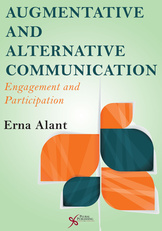Publication
Augmentative and Alternative Communication
Engagement and Participation
- Details:
- 320 pages, Illustrated (B/W), Softcover, 7 x 10"
- ISBN13:
- 978-1-59756-713-8
- Release Date:
- 12/30/2016
Overview
Augmentative and Alternative Communication: Engagement and Participation reexamines the basic components of human communication based on the development of meaning between two people and provides a new theoretical framework for integrating the use of Augmentative and Alternative Communication (AAC) strategies into interpersonal interactions. As such, it is an indispensable resource for speech-language pathologists, special education practitioners, and researchers in AAC, as well as for instructors and graduate students in the fields of speech and hearing sciences and special education.
The book employs a creative synthesis of engagement (personal involvement) and participation (exchanges) to describe meaning-making and social closeness between partners. This process allows for the acknowledgment of different levels of shared meaning and outlines a novel approach to assessment and intervention. The book also describes the importance of integrating relational (interaction-oriented) as well as instrumental (goal-oriented) communication functions as essential in maintaining on-going relationships.
Most resources in AAC tend to emphasize strategies for enhancing participation, rather than strategies associated with the development of engagement ("being with") to enhance communication between communication partners. In contrast, this text uses interactions between users of AAC and their communication partners as a basis to explore the creative synthesis between engagement and participation to provide clinical guidelines for assessment and intervention in both interpersonal and classroom contexts.
Key features:
- A novel theoretical approach focused on engagement and participation as core components in AAC intervention
- Emphasis on empathic listening skills of both communication partner and user of AAC strategies to facilitate engagement (emotional resonance) between them
- Guidance for teachers on the benefits of a meaning-based approach to communication in the classroom
- Application of empathic listening strategies to people with dementia to address an increasing need for care of patients with Alzheimer disease by caregivers and family members
- Integration of social media and face-to-face interactions as central to developing relationships in AAC interactions
Preface
Acknowledgments
Contributors
Part I. Theoretical Framework: Engagement and Participation
Chapter 1. Social Closeness, Relationships, and Communication
Erna Alant
Chapter 2. Engagement and Participation
Erna Alant
Chapter 3. Meaning-Making in the Classroom: Learning From Teachers' Perspectives
Erna Alant, Lindsey N. Ogle, Ohoud Alhajeri, Santoshi Halder, and Paulo Tan
Chapter 4. What Is a Competent User of AAC? Perspectives From AAC Interventionists
Erna Alant, Lindsey N. Ogle, and Ohoud Alhajeri
Part II. AAC Intervention
Chapter 5. AAC Intervention: A Focus on Meaning-Making
Erna Alant
Chapter 6. Case Studies
Erna Alant, Annette Champion, and Erin Colone Peabody
Chapter 7. Empathetic Communication
Erna Alant
Chapter 8. Partner Training in AAC Intervention
Erna Alant
Chapter 9. Engagement, Participation, and People With Severe Dementia
Erna Alant
Chapter 10. Digital Communication and AAC Intervention
Erna Alant
Part III. Future Perspectives
Chapter 11. What Matters Most and the Way Forward
Erna Alant
Index
About The Author
Erna Alant, PhD, was born in South Africa, where she qualified as a speech-language pathologist and received her DPhil in Communication Pathology at the University of Pretoria. After working as a speech-language pathologist at the University of the Witwatersrand and a school for Children with Physical Disabilities, she went back to the University of Pretoria, where she founded the Center for Augmentative and Alternative Communication (CAAC) in 1990. In 1998, she received a Rolex Award for Enterprise (Laureate) for the research and training conducted at the CAAC. In 2009, she moved to the United States, where she accepted a position as professor and Otting Chair in Special Education at Indiana University, Bloomington. She has over 30 years of experience in the field of augmentative and alternative communication and was president of the International Society for Augmentative and Alternative Communication between 2010 and 2012. She has significant clinical experience and has published extensively.
Related Titles
Augmentative and Alternative Communication Intervention
288 pages, Illustrated (B/W), Softcover, 7 x 10"
Hearing Assistive and Access Technology
Samuel R. Atcherson, Clifford A. Franklin, Laura Smith-Olinde
320 pages, Illustrated (B/W), Softcover, 7 x 10"
Patient-Provider Communication
Edited by: Sarah W. Blackstone, David R. Beukelman, Kathryn M. Yorkston
352 pages, Illustrated (B/W), Softcover, 7 x 10"
Augmentative and Alternative Communication in Acute and Critical Care Settings
Richard R. Hurtig, Ph.D., Debora Downey, CCC-SLP
224 pages, Illustrated (B/W), Softcover, 7 x 10"
-














